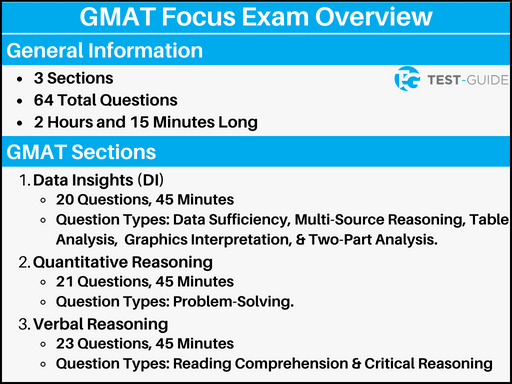The Graduate Management Admission Test (GMAT) is a standardized exam that is used by various colleges and universities in the U.S. as a factor in determining graduate school admissions.
The GMAT is administered by the Graduate Management Admission Council (GMAC). Starting February 1, 2024, the GMAT is being updated to the “GMAT Focus.” Some key features of this new GMAT are:
- Standardized Exam
- 64 Total Questions
- 3 Sections
- 2 Hours and 15 Minutes Long
Learn more about what is on the GMAT, a breakdown of each GMAT section, and more with our complete guide. You can start practicing for the exam with our free GMAT practice test.
What is on the GMAT?
The GMAT is in the process of undergoing some huge changes. Beginning in February 2024, the GMAT Focus will be the current version of the exam that is administered to students.
GMAT Focus Breakdown
This new version of the exam will replace the old version starting in February 2024. This version is shorter, more streamlined, and does not include an essay.
| GMAT Section | Total Number of Questions | Time Limit (Minutes) |
|---|---|---|
| Data Insights | 20 | 45 |
| Quantitative Reasoning | 21 | 45 |
| Verbal Reasoning | 23 | 45 |
Traditional GMAT Breakdown
This version of the exam is the traditional version that has been given the last couple of years. Starting in February 2024, you will only be able to take the GMAT Focus version (listed above).
| GMAT Section | Total Number of Questions | Time Limit (Minutes) |
|---|---|---|
| Analytical Writing | 1 Essay | 30 |
| Integrated Reasoning | 12 | 30 |
| Quantitative Reasoning | 31 | 62 |
| Verbal Reasoning | 36 | 65 |
The GMAT is a computer adaptive exam. This means that the exam gets harder or easier depending on how you are answering the questions.
GMAT Sections
On the new GMAT Focus version of the exam, there are only 3 sections:
- Data Insights
- Quantitative Reasoning
- Integrated Reasoning
The order of the sections is irrelevant. You will be able to take the exam in any order you want on test day.
We dig into each of these sections in greater detail below.
All 3 sections will factor into your total scaled score (205-805). This is different from the old GMAT where only 2 sections counted towards your total scaled score.
Start practicing for these sections with our full-length GMAT practice test.
Data Insights (DI)
| Number of Questions | Time Limit (Minutes) | Score Range |
|---|---|---|
| 20 | 45 | 60-90 |
The GMAT data insights section is a new section that was added to the GMAT Focus exam.
The purpose of this section is to measure your ability to analyze and interpret data and apply it to real-world scenarios.
This section takes questions from the old quantitative reasoning and integrated reasoning sections on the previous version of the GMAT.
You will find various question types like:
- Data Sufficiency
- Multi-Source Reasoning
- Table Analysis
- Graphics Interpretation
- Two-Part Analysis
You will be permitted to use a calculator on this section.
Quantitative Reasoning (QR)
| Number of Questions | Time Limit (Minutes) | Score Range |
|---|---|---|
| 21 | 45 | 60-90 |
The GMAT quantitative reasoning section is remaining on the new GMAT Focus exam. However, there are some changes made to the section:
- Less Questions
- Score Range Has Changed
- No More Data Sufficiency Questions (Moved to Data Insights Section)
The purpose of this section is to measure your knowledge in mathematics and how you apply that knowledge to solving problems.
You will find 1 type of question on this section:
- Problem-Solving
The problem-solving questions will cover topics like:
- Arithmetic
- Algebra
- Statistics
- Fractions, Ratios, and Percentages
- Word Problems
You will not be permitted to use a calculator on this section.
Verbal Reasoning (VR)
| Number of Questions | Time Limit (Minutes) | Score Range |
|---|---|---|
| 23 | 45 | 60-90 |
The GMAT verbal reasoning section is also remaining on the new GMAT Focus exam. There are also some changes made to this section:
- Less Questions
- Score Range Has Changed
- No More Sentence Correction Questions
The purpose of this section is to measure your ability to read and comprehend material.
You will find 2 types of questions on this section:
- Reading Comprehension:
- Critical Reasoning
For reading comprehension questions, you will be asked questions relating to the main idea, supporting idea, inference, application, logical structure, and style.
For critical reasoning questions, you will be asked to read a short passage (less than 100 words) and answer questions relating to arguments.
Answer questions for each section of the GMAT with our free GMAT practice tests.
How Long is the GMAT?
The GMAT Focus exam is 2 hours and 15 minutes long. Each of the 3 sections has a time limit of 45 minutes.
The Focus exam is more streamlined and is 52 minutes shorter than the older version of the GMAT.
Scoring of the GMAT
The scoring system has changed a bit when the GMAC updated the exam to the GMAT Focus exam.
You will receive a total score on a scale from 205-805.
All 3 sections of the exam are scored and equally weighted. Each section is scored on a scale from 60-90.
Your section scores are scaled, which is how you arrive at your total score (205-805). This total score is what schools will mostly use when determining your admission into their program.
You can choose to send your score after you know how you performed, which is a new change made.
You will see your unofficial score report immediately following the exam. You will receive your official score report about 7 business days after your exam.
Read our complete guide to GMAT scores for more in-depth information.
Scheduling and Taking the GMAT
When scheduling your exam, you will have 2 options when it comes to taking the exam:
- Online: Take the exam online with a remote proctor
- Testing Center: Take the exam at a testing center.
The exam is given year-round. There are not specific dates set like with the SAT or ACT.
You can schedule your exam up to 6-months in advance. You can take the exam online at any time (around the clock). Testing centers do not have the same availability, but are typically available 7 days a week.
You will be able to retake your GMAT if you want to. You can take the GMAT a total of 8 times in your life. However, you can only take it 5 times in a calendar year and you must wait 16 days between retakes.
For more information, visit our GMAT test dates article.
Registration and Fees for the GMAT
Registration for the GMAT is relatively straightforward. You can follow these steps:
- Create An Account: Visit MBA.com.
- Choose How You Want to Take the Exam: Online or Testing Center.
- Register for Your Exam: Complete Your Profile, Make Your Payment, and Select Your Date and Time.
The standard fee to take the GMAT online is $300. The standard fee to take the GMAT at a testing center is $275. There are other fees that may be added on like a rescheduling fee, enhanced score reporting, additional score reports, etc…
Here is a full list of fees.
Preparing for Your GMAT
The GMAT is an important exam for individuals interested in getting into a graduate program. Studying for the exam can be very stressful and time-consuming.
We suggest starting off with our GMAT practice tests. The exams are full-length and a great way to gauge where you stand.
Frequently Asked Questions
Is the GMAT multiple-choice?
The GMAT is a multiple-choice exam.
How many sections are there on the GMAT?
The GMAT Focus exam has 3 sections:
- Data Insights
- Quantitative Reasoning
- Verbal Reasoning
You can take the exam in any order you would like on test-day.
How many questions are on the GMAT?
There are 64 total questions on the GMAT Focus exam.
How long is the GMAT?
The GMAT Focus is 2 hours and 15 minutes long. Each of the 3 sections are 45 minutes.
How do you take the GMAT?
You can either take the GMAT at an in-person testing center or remotely online (proctored).
Is the GMAT computer adaptive?
Yes, the GMAT is computer adaptive. This means the difficulty of the questions will adapt based on how you are performing on the exam.
Can you retake the GMAT?
You can take the GMAT a total of 8 times in your lifetime. You can only take it 5 times a year though. You also must wait 16 calendar days between retakes.


